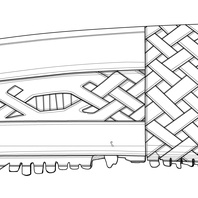
Viking Designs
Drawing of Bone Comb
A drawing of an intricately decorated bone comb found in Lincoln.
Read More
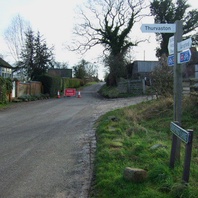
Viking Names
Thurvaston
Thurvaston, in the Appletree Hundred of Derbyshire, comes from the Old Norse male personal name Þurferð and the Old English tun ‘farm, settlement’. It is thus a hybrid name. The same personal name appears in Thoroton in Nottinghamshire. This personal name normally appears in Scandinavian sources in its contracted form, Þórðr, while the full form appears in runic and other sources in Sweden. Thurvaston is a joint parish with Osleston.
Read More
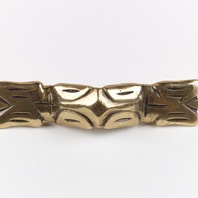
Viking Objects
Reproduction Ansate Brooch
A reproduction, copper alloy, ansate brooch based on an example from York. Two copper alloy examples of ansate brooches, also known as equal-armed brooches, were found at 16-22 Coppergate. These brooches are characterised by a narrow arched bow and terminal heads of identical form. The design of the brooches from Coppergate are a variant known as ‘caterpillar’ type. Asnate brooches are dated to between the seventh and ninth centuries though the finds at Coppergate may extend their popularity into the tenth century. The ‘caterpillar’ variety is typically geographically limited to areas bordering the North Sea. The quantity found in England, however, may indicate local manufacture. Brooches were a typical part of female dress. Scandinavian brooches came in a variety of sizes and shapes which included disc, trefoil, lozenge, equal-armed, and oval shapes. The different brooch types served a variety of functions in Scandinavian female dress with oval brooches typically being used as shoulder clasps for apron-type dresses and the rest being used to secure an outer garment to an inner shift. Anglo-Saxon brooches do not match this diversity of form with large disc brooches being typical of ninth century dress styles with smaller ones becoming more popular in the later ninth and tenth centuries. However, since disc brooches were used by both Anglo-Saxon and Scandinavian women they are distinguished by their morphology. Scandinavian brooches were typically domed with a hollow back while Anglo-Saxon brooches were usually flat. Moreover, Anglo-Saxon brooches were worn singly without accompanying accessories.
Read More
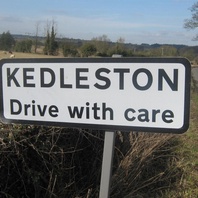
Viking Names
Kedleston
Kedleston, in the Appletree Hundred of Derbyshire, is a hybrid formation of the common Old Norse male personal name Ketill and the Old English element tun ‘farm, settlement’.
Read More
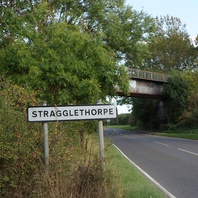
Viking Names
Stragglethorpe
Stragglethorpe, in the Bingham Wapentake of Nottinghamshire, is a hamlet whose name is first recorded in the late eighteenth century. While it does contain the Old Norse element þorp ‘outlying farm, settlement’, it is not clear that the name is as old as the Scandinavian settlement of the region. It has been suggested that it is a name of the late nickname type, referring to an area with a few small straggling farms.
Read More
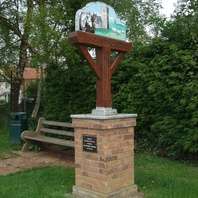
Viking Names
Hogsthorpe
Hogsthorpe, in the South Riding of Lindsey in Lincolnshire, is a hybrid name. The first element of the place-name is either Old English hogg ‘a hog, a pig’ or the Old English male personal name Hogg. The second element is Old Norse þorp ‘a secondary settlement, a dependent outlying farmstead or hamlet’.
Read More
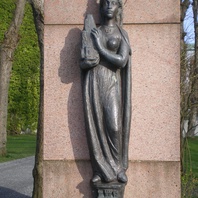
Viking Names
Sunnifa
Sunnifa is a Scandinavianised form of Old English Sunngifu, which was the name of an Irish Christian queen who fled to Norway in the tenth century, according to her legend. She was later venerated as a saint and is the patron saint of Bergen and Western Norway. The name appears in Norway from the eleventh century onwards, but it is rare in Iceland and Denmark. Sunnifa is well-attested in medieval English documents notably in Lincolnshire and Yorkshire, as well as some field-names in West Yorkshire.
Read More

Viking Names
Stenson
Stenson, in the Appletree Hundred of Derbyshire, is an Anglo-Scandinavian compound from the Old Norse male personal name Steinn and Old English tun ‘an enclosure; a farmstead; a village; an estate’. It is a joint parish with Twyford.
Read More
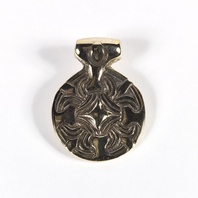
Viking Objects
Reproduction Terslev Pendant
Terslev style, where Scandinavian ring-chain patterns are the main decorative component, is a subcategory of the Borre style and takes its name from the silver hoard discovered in Terslev, Denmark. The decoration comprises a series of ring-knots related to the Borre ring-chain. The Terslev style occurs mainly on brooches and pendants, including both high-quality gold and silver jewellery as well as lower-end base metal items. The cast base-metal ornaments, such as those made of copper alloy, were intended to imitate the higher-end gold and silver jewellery, and often employed techniques such as gilding to achieve this. The Terslev designs that occur in England extend the repertoire by introducing new Scandinavian motifs hitherto unrecorded in Scandinavia. For more information on Scandinavian jewellery in England check out our blog: Brooches, Pendants and Pins: Scandinavian Dress Accessories in England.
Read More
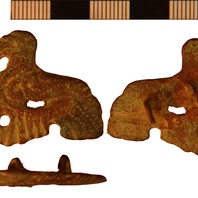
Viking Objects
Viking Bird Brooch (NLM-612074)
This brooch is classified as Weetch’s type 30.C and is decorated with an openwork design representing a bird in profile. For more information on Scandinavian jewellery in England check out our blog: Brooches, Pendants and Pins: Scandinavian Dress Accessories in England.
Read More
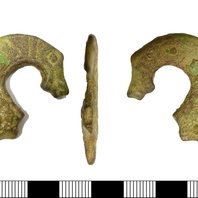
Viking Objects
Copper-Alloy Bridle Bit (LEIC-069A75)
This cast copper-alloy bridle bit fragment is made up of a flat curved section which terminates in a sub-rectangular beast’s stylised head above a ‘trefoil’-shaped projection decorated with an incised spiral motif.
